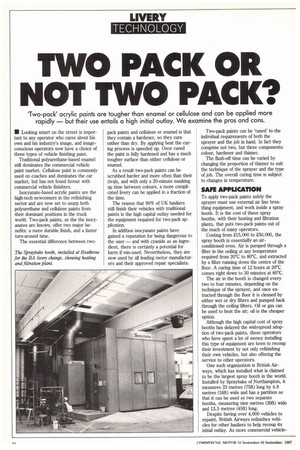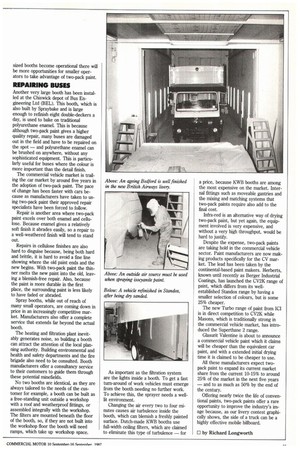TWO PACK OR NOT TWO PACK?
Page 56

Page 57

If you've noticed an error in this article please click here to report it so we can fix it.
• Looking smart on the street is important to any operator who cares about his own and his industry's image, and imageconscious operators now have a choice of three types of vehicle finishing paint.
Traditional polyurethane-based enamel still dominates the commercial vehicle paint market. Cellulose paint is commonly used on coaches and dominates the car market, but has not found favour with commercial vehicle finishers.
Isocyanate-based acrylic paints are the high-tech newcomers in the refinishing sector and are now set to usurp both polyurethane and cellulose paints from their dominant positions in the truck world. Two-pack paints, as the the isocyanates are known, offer two major benefits: a more durable finish, and a faster turn-around time.
The essential difference between two pack paints and cellulose or enamel is that they contain a hardener, so they cure rather than dry. By applying heat the curing process is speeded up. Once cured the paint is fully hardened and has a much tougher surface than either cellulose or enamel.
As a result two-pack paints can be scrubbed harder and more often than their rivals, and with only a 20-minute masking up time between colours, a more complicated livery can be applied in a fraction of the time.
The reason that 90% of UK hauliers still finish their vehicles with traditional paints is the high capital outlay needed for the equipment required for two-pack application.
In addition isocyanate paints have gained a reputation for being dangerous to the user — and with cyanide as an ingredient, there is certainly a potential for harm if mis-used. Nevertheless, they are now used by all leading motor manufacturers and their approved repair specialists. Two-pack paints can be 'tuned' to the individual requirements of both the sprayer and the job in hand. In fact they comprise not two, but three components: colour, hardener and thinner.
The flash-off time can be varied by changing the proportion of thinner to suit the technique of the sprayer and the type of job. The overall curing time is subject to changes in temperature.
To apply two-pack paints safely the sprayer must use external air line breathing equipment, and work inside a spray booth. It is the cost of these spray booths, with their heating and filtration plants, that puts two-pack paints out of the reach of many operators.
Costing from 215,000 to 250,000, the spray booth is essentially an airconditioned oven. Air is pumped through a filter in the ceiling at any temperature required from 20°C to 80°C, and extracted by a filter running down the centre of the floor. A curing time of 12 hours at 20°C comes right down to 30 minutes at 60°C.
The air in the booth is changed every two to four minutes, depending on the technique of the sprayer, and once extracted through the floor it is cleaned by either wet or dry filters and pumped back through the ceiling filters. Oil or gas can be used to heat the air, oil is the cheaper option.
Although the high capital cost of spray booths has delayed the widespread adoption of two-pack paints, those operators who have spent a lot of money installing this type of equipment are keen to recoup their investment by not only refinishing their own vehicles, but also offering the service to other operators.
One such organization is British Airways, which has installed what is claimed to be the largest spray booth in the world. Installed by Spraybake of Northampton, it measures 23 metres (75ft) long by 4.8 metres (16ft) wide and has a partition so that it can be used as two separate booths, measuring nine metres (30ft) wide and 13.5 metres (45ft) long.
Despite having over 4,000 vehicles to repaint, British Airways refinishes vehicles for other hauliers to help recoup its initial outlay. As more commercial vehicle sized booths become operational there will be more opportunities for smaller operators to take advantage of two-pack paint.
Another very large booth has been installed at the Chiswick depot of Bus Engineering Ltd (BEL). This booth, which is also built by Spraybake and is large enough to refinish eight double-deckers a day, is used to bake on traditional polyurethane enamel. This is because although two-pack paint gives a higher quality repair, many buses are damaged out in the field and have to be repaired on the spot — and polyurethane enamel can be brushed on anywhere, without any sophisticated equipment. This is particularly useful for buses where the colour is more important than the detail finish.
The commercial vehicle market is trailing the car market by around five years in the adoption of two-pack paint. The pace of change has been faster with cars because as manufacturers have taken to using two-pack paint their approved repair specialists have been forced to follow.
Repair is another area where two-pack paint excels over both enamel and cellulose. Because enamel gives a relatively soft finish it abrades easily, so a repair to a well-weathered finish will tend to stand out.
Repairs in cellulose finishes are also hard to disguise because, being both hard and brittle, it is hard to avoid a fine line showing where the old paint ends and the new begins. With two-pack paint the thinner melts the new paint into the old, leaving a blemish-free repair. Also, because the paint is more durable in the first place, the surrounding paint is less likely to have faded or abraded.
Spray booths, while out of reach of many small operators, are coming down in price in an increasingly competitive market. Manufacturers also offer a complete service that extends far beyond the actual booth.
The heating and filtration plant inevitably generates noise, so building a booth can attract the attention of the local planning authority. Building environmental and health and safety departments and the fire brigade also need to be consulted. Booth manufacturers offer a consultancy service to their customers to guide them through these potential minefields.
No two booths are identical, as they are always tailored to the needs of the customer for example, a booth can be built as a free-standing unit outside a workshop with a roof and weatherproof fittings, or assembled integrally with the workshop. The filters are mounted beneath the floor of the booth, so, if they are not built into the workshop floor the booth will need ramps, which take up workshop space. As important as the filtration system are the lights inside a booth. To get a fast turn-around of work vehicles must emerge from the booth needing no further work. To achieve this, the sprayer needs a welllit environment.
Changing the air every two to four minutes causes air turbulence inside the booth, which can blemish a freshly painted surface. Dutch-made KWB booths use full-width ceiling filters, which are claimed to eliminate this type of turbulence — for a price, because KWB booths are among the most expensive on the market. Internal fittings such as moveable gantries and the mixing and matching systems that two-pack paints require also add to the final cost.
Infra-red is an alternative way of drying two-pack paint, but yet again, the equipment involved is very expensive, and without a very high throughput, would be hard to justify.
Despite the expense, two-pack paints are taking hold in the commercial vehicle sector. Paint manufacturers are now making products specifically for the CV market. The lead has been taken by the continental-based paint makers. Herberts, known until recently as Berger Industrial Coatings, has Launched the CV2K range of paint, which differs from its wellestablished Standox range by having a smaller selection of colours, but is some 25% cheaper.
The new Turbo range of paint from ICI is in direct competition to CV2K while Masons, which is traditionally strong in the commercial vehicle market, has introduced the Superthane 2 range.
Glasurit Valentine is about to announce a commercial vehicle paint which it claims will be cheaper than the equivalent car paint, and with a extended initial drying time it is claimed to be cheaper to use.
All these manufacturers expect twopack paint to expand its current market share from the current 10-15% to around 25% of the market in the next five years — and to as much as 50% by the end of the century.
Offering nearly twice the life of conventional paints, two-pack paints offer a rare opportunity to improve the industry's image because, as our livery contest graphically shows, the side of a truck can be a highly effective mobile billboard.












































































































